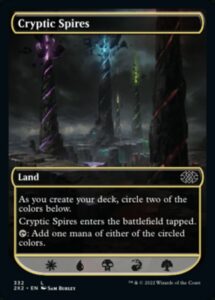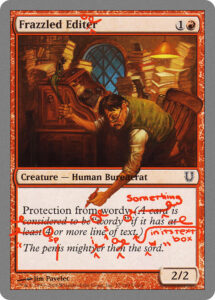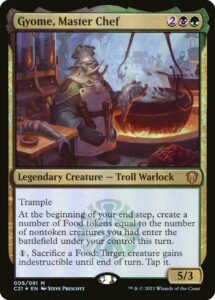Gavin Verhey put it well.
“Cryptic Spires is one of the most bizarre cards we’ve ever made.”
Mana fixing is an integral element of every Limited format. Tricolor formats like Khans of Tarkir, Modern Masters 2015, and Double Masters depend on having high quantities of fixing to fixing. However, even the most monocolor-focused sets like Throne of Eldraine contain some amount of fixing (Golden Egg) so that players can both entertain splashing a color and play more consistent manabases than 17 basic lands affords.
In short, fixing is present in nearly all Limited formats, but common land-fixing tends to take three forms: guildgates (which provide two colors and enter the battlefield tapped), Evolving Wilds (which fetch a basic land, also tapped), and Shimmering Grottos (which fix mana at a cost). Cryptic Spires is a novel solution to contemporary Magic’s constant need for fixing, and it does so by upending the very concept of dual lands.

Smart Design
There is a lot going for Cryptic Spires. It solves multiple problems at once in an unprecedented fashion. I’d planned on detailing it benefits at length, but opted to trim this section down after seeing Gavin Verhey’s fantastic explanation in his aforementioned deep dive.
First, Cryptic Spires allows drafters to pivot mid-draft, especially those that prioritize fixing. All other dual lands lock in their mana fixing, but Cryptic Spires won’t leave the drafter who overvalues fixing with dual lands rotting in their sideboard.
Second, Cryptic Spires only takes up a single card slot in the set file and in the pack. There don’t have to be ten unique card arts commissioned or packs with 3+ dual lands taking the place of castable spells. We’ve seen packs have dedicated dual land slots like Dragon’s Maze’s guildgates or snow lands in Kaldheim, and this is an even simpler approach.
Third, Cryptic Spires creates consistency. Every drafter knows that there will be exactly 24 Cryptic Spires each draft and can plan to value (and track) them using this information. Players don’t have to scramble to grab whatever fixing comes their way, since they won’t know what could be in the packs. More importantly, every Cryptic Spires fits in every deck (well, every non-monocolor deck), so they’re essentially guaranteed to be useful to everyone, whereas a draft that happened to have five Tranquil Coves and zero Bloodfell Caves would randomly favor WU drafts and disfavor BR drafters.
Fourth, Cryptic Spires does a good job of enabling three-color play while making 4-5 color goodstuff decks harder to draft. Lands like Evolving Wilds and Ash Barrens make it possible to have a single basic land provide 3+ sources of a color. This can make it facile to splash a color while minimizing the clunkiness that color adds to your draws. By locking players into only two colors, Cryptic Spires makes it much harder to consistently find a fourth color without a real cost (like most of your lands entering the battlefield tapped or spending spell slots on cards like Rampant Growth and Fiery Fall). That’s a good goal for a set aiming to have discrete tricolor combinations.
With all that going for it, one could imagine that Cryptic Spires is an unmitigated success and we’re likely to see more of that in the future. However, the card is not without issues. I’ve extensively played with it on Magic Online and had the opportunity to draft it in paper, and each presented their own challenges.

The trouble with marking and marked cards
I encountered two issues playing with Cryptic Spires in paper: marking the cards and playing with them.
It’s hard to write on Magic cards. Most of my pens don’t write nicely on them (and tend to leave indentations), so I have to bring a writing implement that easily marks the cards’ front sides without also marking their back sides. This is a familiar challenge to anyone using checklist cards, and so I remembered to bring a sharpie with me—which I then lent out because other players hadn’t prepared. So, it’s a minor annoyance and not a new one.
My bigger issue was keeping track of which of my Cryptic Spires tapped for which colors of mana. Keeping track of lands isn’t always the easiest thing, but most dual lands have convenient colored borders and distinguishing artwork to help you tell them apart. Cryptic Spires necessarily cannot do either of those things in paper. I could imagine a version with a giant art box that expected you to sharpie over 3/5ths of the artwork to help it more clearly show its cases, but that just exacerbates the prior issue.
I wish I’d had more opportunity to draft Double Masters 2022 in person and see whether these complaints are mere quibbles from engaging with a semi-familiar situation or an actual qualms. Alas, the format is in short supply and I don’t expect to get to draft it beyond this week. However, I have gotten in at least 15 drafts on Magic Online and feel confident remarking on how it plays there.

Give me a meal, not raw ingredients
The flexibility Cryptic Spires affords has a downside—it demands much more from the player. With all other dual lands, you review what you have access to during deckbuilding, and you make a choice about how many basic lands to add (and whether to exclude any nonbasics). The lands you have help inform your decision.
Every copy of Cryptic Spires adds its own choice. With a two color deck, the choice is facile, but it’s challenging beyond that. When do you split Cryptic Spires them evenly among your colors? When do you commit to your splash color always entering the battlefield tapped and when don’t you?
These could be growing pains as we learn the heuristics of this unique dual land, but I’ll admit—I enjoy deckbuilding less with Cryptic Spires. I feel like it presents too many choices, none of which are especially interesting or feel especially impactful. Every Cryptic Spires only adds a single color source, so it’s hardly a monumental decision, and yet every single one of them requires brainpower. Each one presents an opportunity to squeeze out a fractional win percentage by streamlining my manabase, but I don’t enjoy the process at all.
Sure, Cryptic Spires is functionally better than Izzet Guildgate, but Izzet Guildgate is an easier card to build a deck with—either I use it or I don’t. As someone who loves building five color piles in Cube, who absolutely adores filling a deck with nonbasic lands, I enjoy it a lot more when I know what I’m working with rather than when I have too many options. It feels like going to a great restaurant, and instead of having a menu, the head chef comes out with an array of ingredients and asks me which she should use and to make which dishes. I came from the experience of having the meal, not the experience of planning it.
Ultimately, I’m mixed on Cryptic Spires. It reminds me a lot of Daybound, a mechanic I appreciate for all the issues it addresses that I also dislike for the issues it causes. But, that’s the thing with all design choices—you can never optimize for every player and play experience. And, as always, I appreciate Wizards finding yet another way to innovate despite the game entering its thirtieth year.
Zachary Barash is a New York City-based game designer and the last commissioner of Team Draft League. He designs for Kingdom Death: Monster, has a Game Design MFA from the NYU Game Center, and does freelance game design. When the stars align, he streams Magic (but the stars align way less often than he’d like).

